System Analysis Report: Headspace NewAccess Project Requirements
VerifiedAdded on 2023/01/24
|5
|1648
|49
Report
AI Summary
This report analyzes the Headspace organization's NewAccess system, designed to support youth aged 12-24 with mental health issues. The analysis includes a stakeholder map identifying key groups like sponsors, government, healthcare providers, administrators, patients, and citizens, detailing their roles and interests. A questionnaire is developed for mental health patients to gather their perspectives and requirements for the system. Furthermore, the report provides a use case diagram and detailed descriptions for system functions such as patient registration, story input, retrieval, and administrative tasks. The document aims to understand stakeholder expectations, especially from patients, to ensure successful project implementation and improved patient care. The report references key literature on stakeholder analysis, requirements elicitation, mental health care, and information systems.
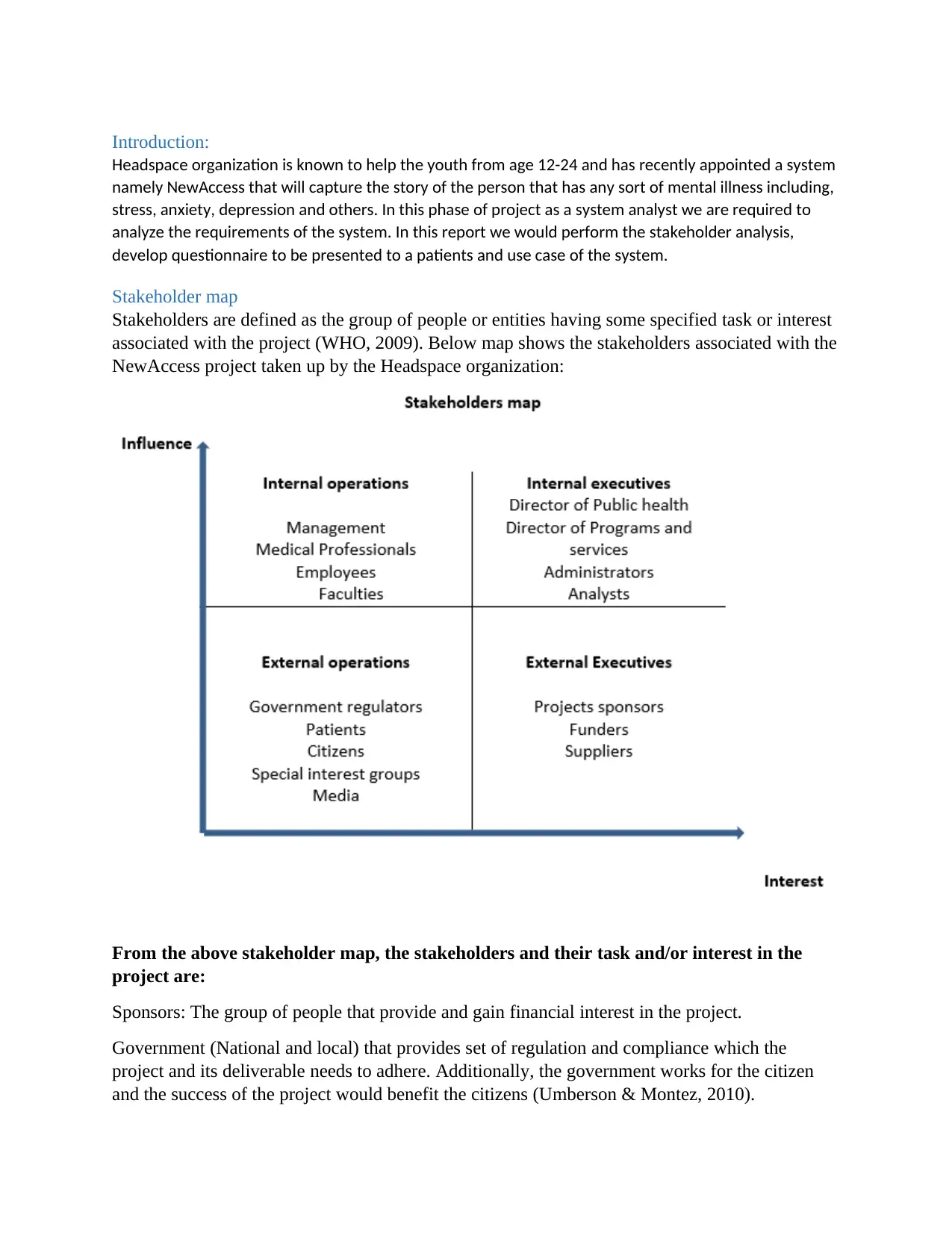
Introduction:
Headspace organization is known to help the youth from age 12-24 and has recently appointed a system
namely NewAccess that will capture the story of the person that has any sort of mental illness including,
stress, anxiety, depression and others. In this phase of project as a system analyst we are required to
analyze the requirements of the system. In this report we would perform the stakeholder analysis,
develop questionnaire to be presented to a patients and use case of the system.
Stakeholder map
Stakeholders are defined as the group of people or entities having some specified task or interest
associated with the project (WHO, 2009). Below map shows the stakeholders associated with the
NewAccess project taken up by the Headspace organization:
From the above stakeholder map, the stakeholders and their task and/or interest in the
project are:
Sponsors: The group of people that provide and gain financial interest in the project.
Government (National and local) that provides set of regulation and compliance which the
project and its deliverable needs to adhere. Additionally, the government works for the citizen
and the success of the project would benefit the citizens (Umberson & Montez, 2010).
Headspace organization is known to help the youth from age 12-24 and has recently appointed a system
namely NewAccess that will capture the story of the person that has any sort of mental illness including,
stress, anxiety, depression and others. In this phase of project as a system analyst we are required to
analyze the requirements of the system. In this report we would perform the stakeholder analysis,
develop questionnaire to be presented to a patients and use case of the system.
Stakeholder map
Stakeholders are defined as the group of people or entities having some specified task or interest
associated with the project (WHO, 2009). Below map shows the stakeholders associated with the
NewAccess project taken up by the Headspace organization:
From the above stakeholder map, the stakeholders and their task and/or interest in the
project are:
Sponsors: The group of people that provide and gain financial interest in the project.
Government (National and local) that provides set of regulation and compliance which the
project and its deliverable needs to adhere. Additionally, the government works for the citizen
and the success of the project would benefit the citizens (Umberson & Montez, 2010).
Paraphrase This Document
Need a fresh take? Get an instant paraphrase of this document with our AI Paraphraser
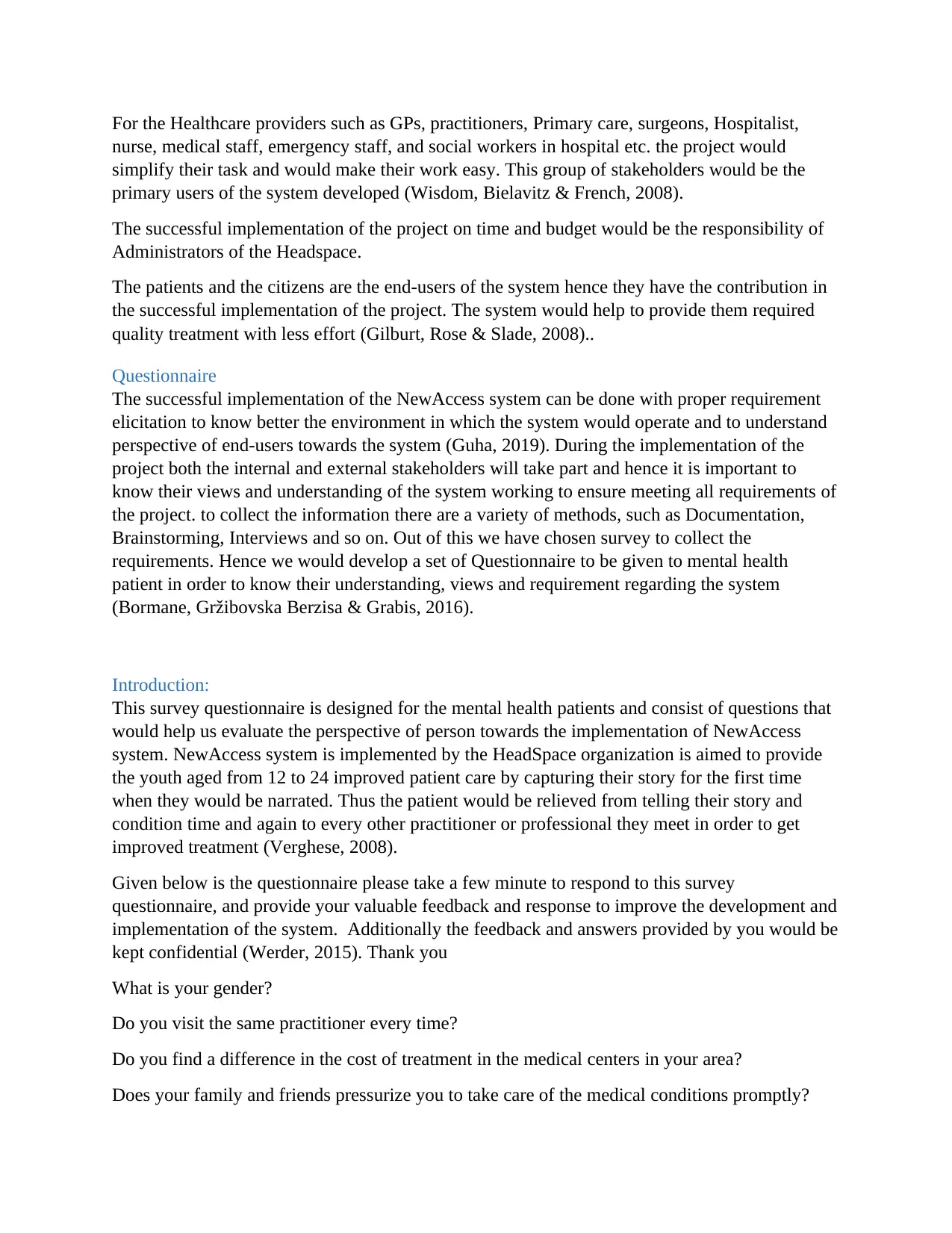
For the Healthcare providers such as GPs, practitioners, Primary care, surgeons, Hospitalist,
nurse, medical staff, emergency staff, and social workers in hospital etc. the project would
simplify their task and would make their work easy. This group of stakeholders would be the
primary users of the system developed (Wisdom, Bielavitz & French, 2008).
The successful implementation of the project on time and budget would be the responsibility of
Administrators of the Headspace.
The patients and the citizens are the end-users of the system hence they have the contribution in
the successful implementation of the project. The system would help to provide them required
quality treatment with less effort (Gilburt, Rose & Slade, 2008)..
Questionnaire
The successful implementation of the NewAccess system can be done with proper requirement
elicitation to know better the environment in which the system would operate and to understand
perspective of end-users towards the system (Guha, 2019). During the implementation of the
project both the internal and external stakeholders will take part and hence it is important to
know their views and understanding of the system working to ensure meeting all requirements of
the project. to collect the information there are a variety of methods, such as Documentation,
Brainstorming, Interviews and so on. Out of this we have chosen survey to collect the
requirements. Hence we would develop a set of Questionnaire to be given to mental health
patient in order to know their understanding, views and requirement regarding the system
(Bormane, Gržibovska Berzisa & Grabis, 2016).
Introduction:
This survey questionnaire is designed for the mental health patients and consist of questions that
would help us evaluate the perspective of person towards the implementation of NewAccess
system. NewAccess system is implemented by the HeadSpace organization is aimed to provide
the youth aged from 12 to 24 improved patient care by capturing their story for the first time
when they would be narrated. Thus the patient would be relieved from telling their story and
condition time and again to every other practitioner or professional they meet in order to get
improved treatment (Verghese, 2008).
Given below is the questionnaire please take a few minute to respond to this survey
questionnaire, and provide your valuable feedback and response to improve the development and
implementation of the system. Additionally the feedback and answers provided by you would be
kept confidential (Werder, 2015). Thank you
What is your gender?
Do you visit the same practitioner every time?
Do you find a difference in the cost of treatment in the medical centers in your area?
Does your family and friends pressurize you to take care of the medical conditions promptly?
nurse, medical staff, emergency staff, and social workers in hospital etc. the project would
simplify their task and would make their work easy. This group of stakeholders would be the
primary users of the system developed (Wisdom, Bielavitz & French, 2008).
The successful implementation of the project on time and budget would be the responsibility of
Administrators of the Headspace.
The patients and the citizens are the end-users of the system hence they have the contribution in
the successful implementation of the project. The system would help to provide them required
quality treatment with less effort (Gilburt, Rose & Slade, 2008)..
Questionnaire
The successful implementation of the NewAccess system can be done with proper requirement
elicitation to know better the environment in which the system would operate and to understand
perspective of end-users towards the system (Guha, 2019). During the implementation of the
project both the internal and external stakeholders will take part and hence it is important to
know their views and understanding of the system working to ensure meeting all requirements of
the project. to collect the information there are a variety of methods, such as Documentation,
Brainstorming, Interviews and so on. Out of this we have chosen survey to collect the
requirements. Hence we would develop a set of Questionnaire to be given to mental health
patient in order to know their understanding, views and requirement regarding the system
(Bormane, Gržibovska Berzisa & Grabis, 2016).
Introduction:
This survey questionnaire is designed for the mental health patients and consist of questions that
would help us evaluate the perspective of person towards the implementation of NewAccess
system. NewAccess system is implemented by the HeadSpace organization is aimed to provide
the youth aged from 12 to 24 improved patient care by capturing their story for the first time
when they would be narrated. Thus the patient would be relieved from telling their story and
condition time and again to every other practitioner or professional they meet in order to get
improved treatment (Verghese, 2008).
Given below is the questionnaire please take a few minute to respond to this survey
questionnaire, and provide your valuable feedback and response to improve the development and
implementation of the system. Additionally the feedback and answers provided by you would be
kept confidential (Werder, 2015). Thank you
What is your gender?
Do you visit the same practitioner every time?
Do you find a difference in the cost of treatment in the medical centers in your area?
Does your family and friends pressurize you to take care of the medical conditions promptly?
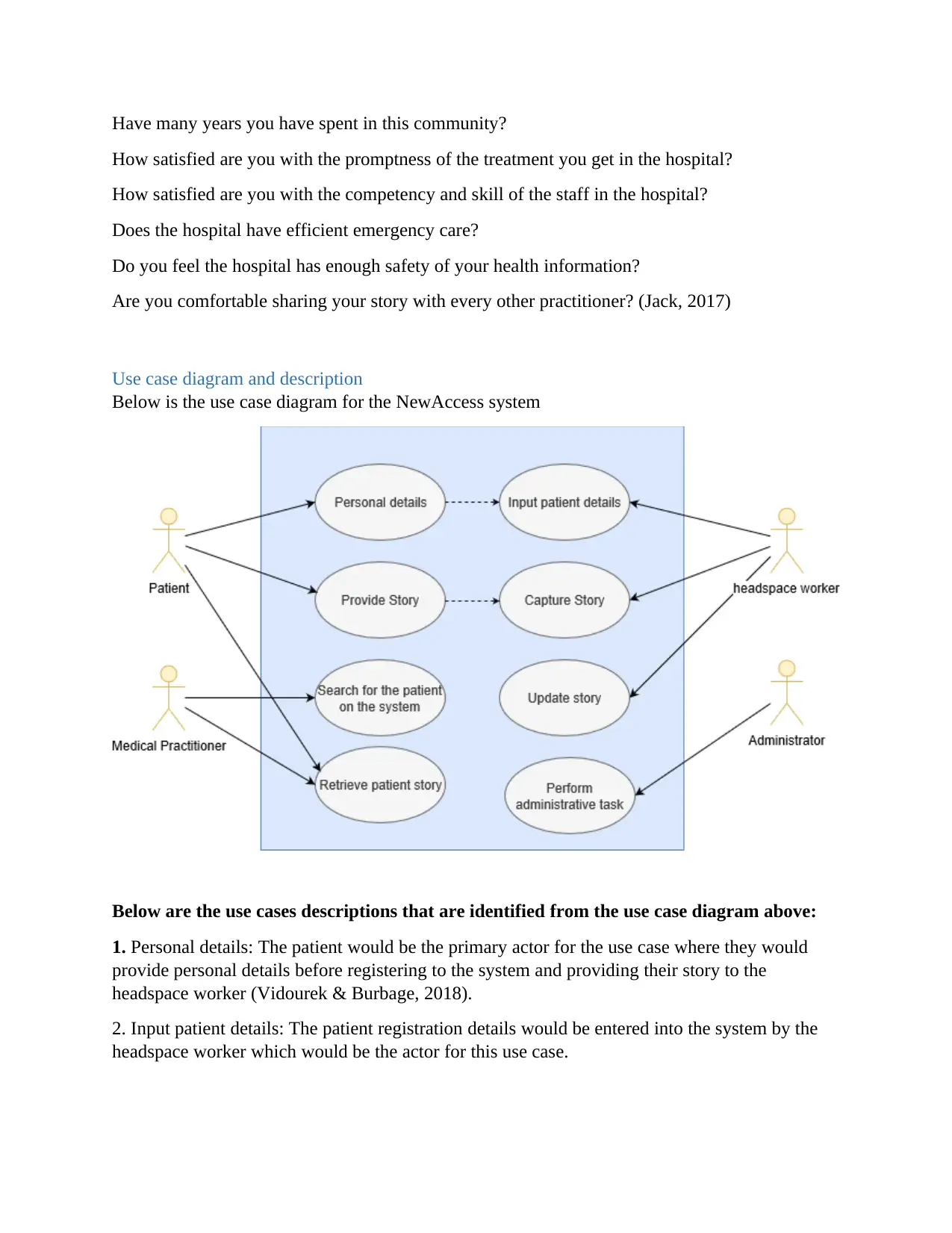
Have many years you have spent in this community?
How satisfied are you with the promptness of the treatment you get in the hospital?
How satisfied are you with the competency and skill of the staff in the hospital?
Does the hospital have efficient emergency care?
Do you feel the hospital has enough safety of your health information?
Are you comfortable sharing your story with every other practitioner? (Jack, 2017)
Use case diagram and description
Below is the use case diagram for the NewAccess system
Below are the use cases descriptions that are identified from the use case diagram above:
1. Personal details: The patient would be the primary actor for the use case where they would
provide personal details before registering to the system and providing their story to the
headspace worker (Vidourek & Burbage, 2018).
2. Input patient details: The patient registration details would be entered into the system by the
headspace worker which would be the actor for this use case.
How satisfied are you with the promptness of the treatment you get in the hospital?
How satisfied are you with the competency and skill of the staff in the hospital?
Does the hospital have efficient emergency care?
Do you feel the hospital has enough safety of your health information?
Are you comfortable sharing your story with every other practitioner? (Jack, 2017)
Use case diagram and description
Below is the use case diagram for the NewAccess system
Below are the use cases descriptions that are identified from the use case diagram above:
1. Personal details: The patient would be the primary actor for the use case where they would
provide personal details before registering to the system and providing their story to the
headspace worker (Vidourek & Burbage, 2018).
2. Input patient details: The patient registration details would be entered into the system by the
headspace worker which would be the actor for this use case.
⊘ This is a preview!⊘
Do you want full access?
Subscribe today to unlock all pages.

Trusted by 1+ million students worldwide
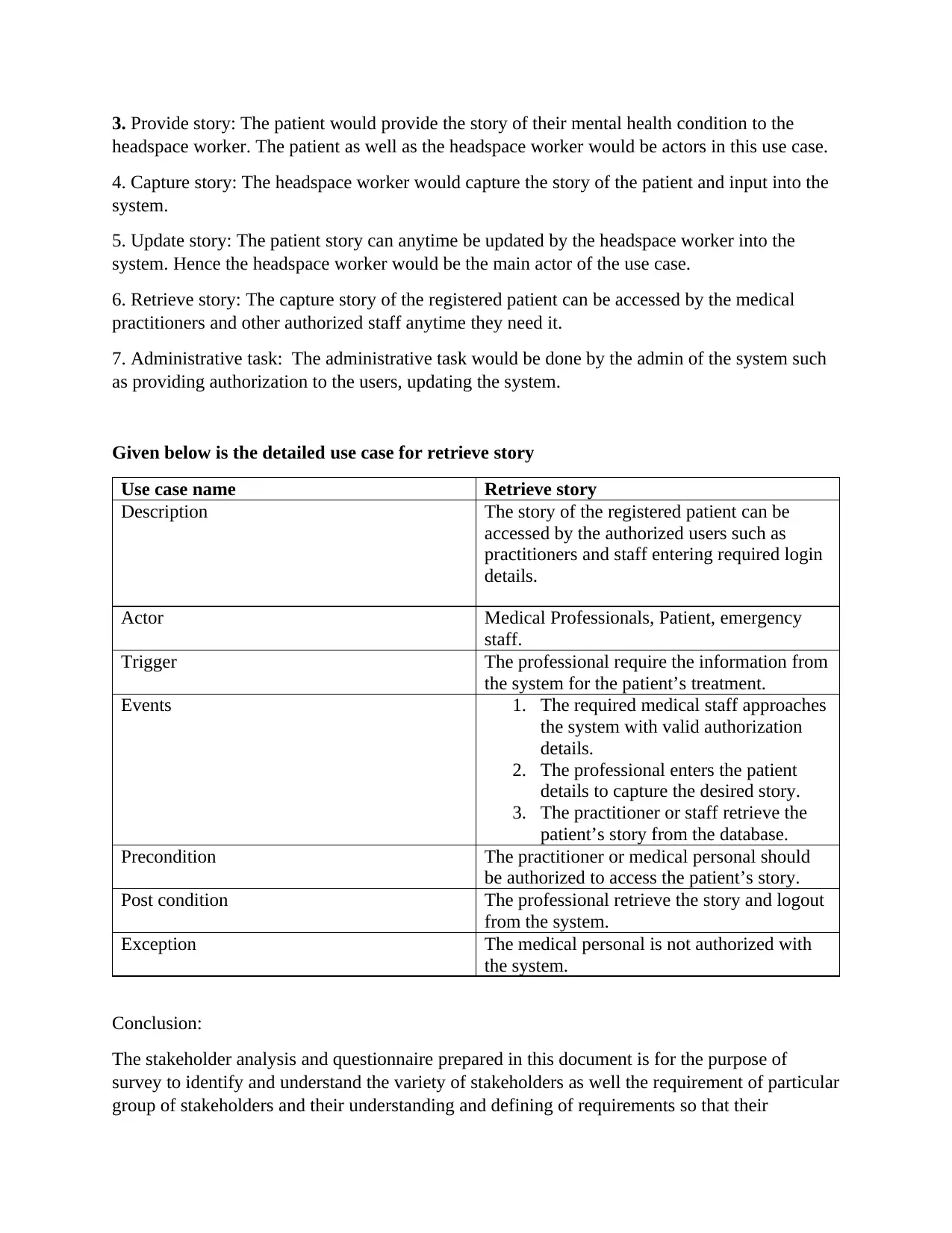
3. Provide story: The patient would provide the story of their mental health condition to the
headspace worker. The patient as well as the headspace worker would be actors in this use case.
4. Capture story: The headspace worker would capture the story of the patient and input into the
system.
5. Update story: The patient story can anytime be updated by the headspace worker into the
system. Hence the headspace worker would be the main actor of the use case.
6. Retrieve story: The capture story of the registered patient can be accessed by the medical
practitioners and other authorized staff anytime they need it.
7. Administrative task: The administrative task would be done by the admin of the system such
as providing authorization to the users, updating the system.
Given below is the detailed use case for retrieve story
Use case name Retrieve story
Description The story of the registered patient can be
accessed by the authorized users such as
practitioners and staff entering required login
details.
Actor Medical Professionals, Patient, emergency
staff.
Trigger The professional require the information from
the system for the patient’s treatment.
Events 1. The required medical staff approaches
the system with valid authorization
details.
2. The professional enters the patient
details to capture the desired story.
3. The practitioner or staff retrieve the
patient’s story from the database.
Precondition The practitioner or medical personal should
be authorized to access the patient’s story.
Post condition The professional retrieve the story and logout
from the system.
Exception The medical personal is not authorized with
the system.
Conclusion:
The stakeholder analysis and questionnaire prepared in this document is for the purpose of
survey to identify and understand the variety of stakeholders as well the requirement of particular
group of stakeholders and their understanding and defining of requirements so that their
headspace worker. The patient as well as the headspace worker would be actors in this use case.
4. Capture story: The headspace worker would capture the story of the patient and input into the
system.
5. Update story: The patient story can anytime be updated by the headspace worker into the
system. Hence the headspace worker would be the main actor of the use case.
6. Retrieve story: The capture story of the registered patient can be accessed by the medical
practitioners and other authorized staff anytime they need it.
7. Administrative task: The administrative task would be done by the admin of the system such
as providing authorization to the users, updating the system.
Given below is the detailed use case for retrieve story
Use case name Retrieve story
Description The story of the registered patient can be
accessed by the authorized users such as
practitioners and staff entering required login
details.
Actor Medical Professionals, Patient, emergency
staff.
Trigger The professional require the information from
the system for the patient’s treatment.
Events 1. The required medical staff approaches
the system with valid authorization
details.
2. The professional enters the patient
details to capture the desired story.
3. The practitioner or staff retrieve the
patient’s story from the database.
Precondition The practitioner or medical personal should
be authorized to access the patient’s story.
Post condition The professional retrieve the story and logout
from the system.
Exception The medical personal is not authorized with
the system.
Conclusion:
The stakeholder analysis and questionnaire prepared in this document is for the purpose of
survey to identify and understand the variety of stakeholders as well the requirement of particular
group of stakeholders and their understanding and defining of requirements so that their
Paraphrase This Document
Need a fresh take? Get an instant paraphrase of this document with our AI Paraphraser
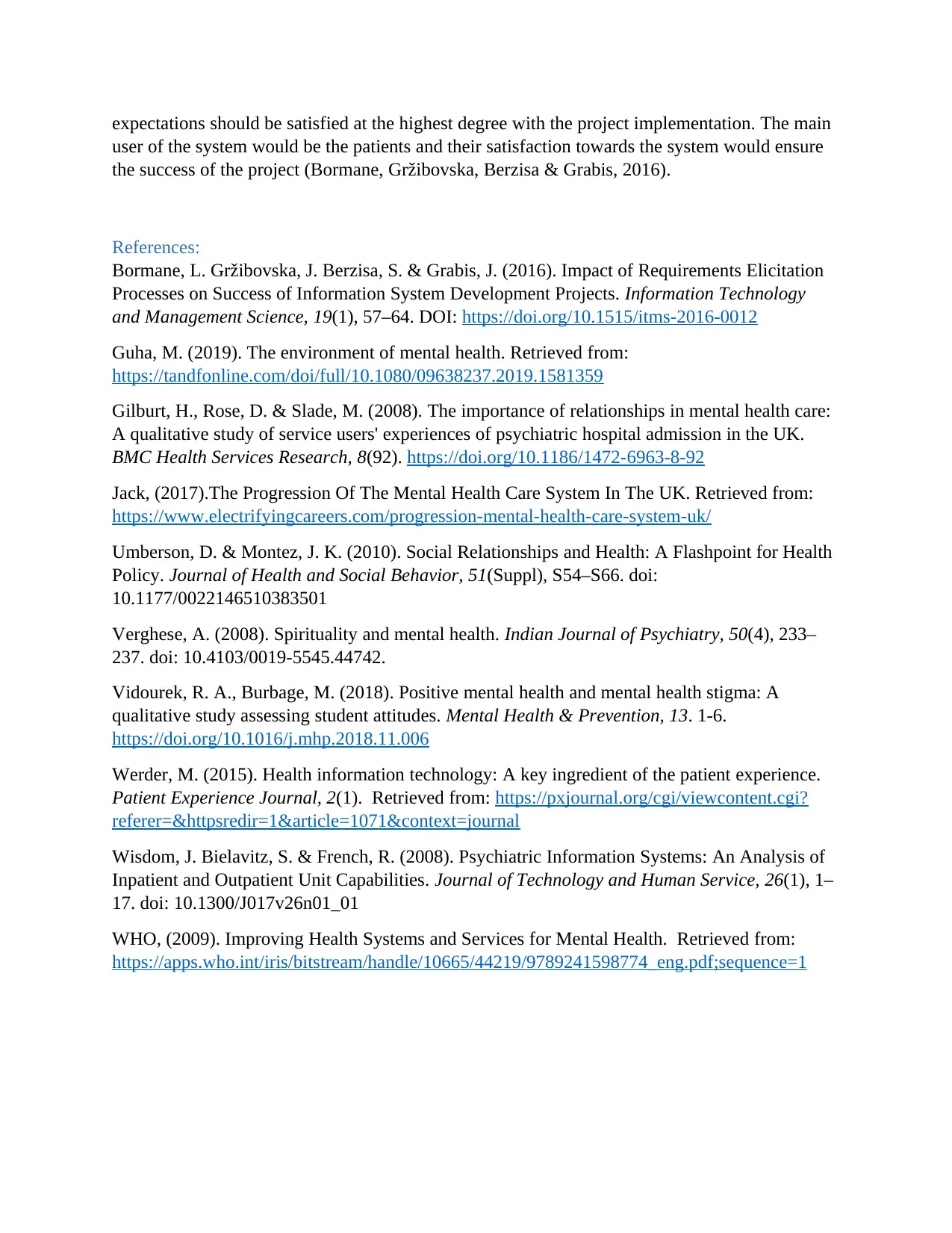
expectations should be satisfied at the highest degree with the project implementation. The main
user of the system would be the patients and their satisfaction towards the system would ensure
the success of the project (Bormane, Gržibovska, Berzisa & Grabis, 2016).
References:
Bormane, L. Gržibovska, J. Berzisa, S. & Grabis, J. (2016). Impact of Requirements Elicitation
Processes on Success of Information System Development Projects. Information Technology
and Management Science, 19(1), 57–64. DOI: https://doi.org/10.1515/itms-2016-0012
Guha, M. (2019). The environment of mental health. Retrieved from:
https://tandfonline.com/doi/full/10.1080/09638237.2019.1581359
Gilburt, H., Rose, D. & Slade, M. (2008). The importance of relationships in mental health care:
A qualitative study of service users' experiences of psychiatric hospital admission in the UK.
BMC Health Services Research, 8(92). https://doi.org/10.1186/1472-6963-8-92
Jack, (2017).The Progression Of The Mental Health Care System In The UK. Retrieved from:
https://www.electrifyingcareers.com/progression-mental-health-care-system-uk/
Umberson, D. & Montez, J. K. (2010). Social Relationships and Health: A Flashpoint for Health
Policy. Journal of Health and Social Behavior, 51(Suppl), S54–S66. doi:
10.1177/0022146510383501
Verghese, A. (2008). Spirituality and mental health. Indian Journal of Psychiatry, 50(4), 233–
237. doi: 10.4103/0019-5545.44742.
Vidourek, R. A., Burbage, M. (2018). Positive mental health and mental health stigma: A
qualitative study assessing student attitudes. Mental Health & Prevention, 13. 1-6.
https://doi.org/10.1016/j.mhp.2018.11.006
Werder, M. (2015). Health information technology: A key ingredient of the patient experience.
Patient Experience Journal, 2(1). Retrieved from: https://pxjournal.org/cgi/viewcontent.cgi?
referer=&httpsredir=1&article=1071&context=journal
Wisdom, J. Bielavitz, S. & French, R. (2008). Psychiatric Information Systems: An Analysis of
Inpatient and Outpatient Unit Capabilities. Journal of Technology and Human Service, 26(1), 1–
17. doi: 10.1300/J017v26n01_01
WHO, (2009). Improving Health Systems and Services for Mental Health. Retrieved from:
https://apps.who.int/iris/bitstream/handle/10665/44219/9789241598774_eng.pdf;sequence=1
user of the system would be the patients and their satisfaction towards the system would ensure
the success of the project (Bormane, Gržibovska, Berzisa & Grabis, 2016).
References:
Bormane, L. Gržibovska, J. Berzisa, S. & Grabis, J. (2016). Impact of Requirements Elicitation
Processes on Success of Information System Development Projects. Information Technology
and Management Science, 19(1), 57–64. DOI: https://doi.org/10.1515/itms-2016-0012
Guha, M. (2019). The environment of mental health. Retrieved from:
https://tandfonline.com/doi/full/10.1080/09638237.2019.1581359
Gilburt, H., Rose, D. & Slade, M. (2008). The importance of relationships in mental health care:
A qualitative study of service users' experiences of psychiatric hospital admission in the UK.
BMC Health Services Research, 8(92). https://doi.org/10.1186/1472-6963-8-92
Jack, (2017).The Progression Of The Mental Health Care System In The UK. Retrieved from:
https://www.electrifyingcareers.com/progression-mental-health-care-system-uk/
Umberson, D. & Montez, J. K. (2010). Social Relationships and Health: A Flashpoint for Health
Policy. Journal of Health and Social Behavior, 51(Suppl), S54–S66. doi:
10.1177/0022146510383501
Verghese, A. (2008). Spirituality and mental health. Indian Journal of Psychiatry, 50(4), 233–
237. doi: 10.4103/0019-5545.44742.
Vidourek, R. A., Burbage, M. (2018). Positive mental health and mental health stigma: A
qualitative study assessing student attitudes. Mental Health & Prevention, 13. 1-6.
https://doi.org/10.1016/j.mhp.2018.11.006
Werder, M. (2015). Health information technology: A key ingredient of the patient experience.
Patient Experience Journal, 2(1). Retrieved from: https://pxjournal.org/cgi/viewcontent.cgi?
referer=&httpsredir=1&article=1071&context=journal
Wisdom, J. Bielavitz, S. & French, R. (2008). Psychiatric Information Systems: An Analysis of
Inpatient and Outpatient Unit Capabilities. Journal of Technology and Human Service, 26(1), 1–
17. doi: 10.1300/J017v26n01_01
WHO, (2009). Improving Health Systems and Services for Mental Health. Retrieved from:
https://apps.who.int/iris/bitstream/handle/10665/44219/9789241598774_eng.pdf;sequence=1
1 out of 5
Related Documents
Your All-in-One AI-Powered Toolkit for Academic Success.
+13062052269
info@desklib.com
Available 24*7 on WhatsApp / Email
![[object Object]](/_next/static/media/star-bottom.7253800d.svg)
Unlock your academic potential
Copyright © 2020–2025 A2Z Services. All Rights Reserved. Developed and managed by ZUCOL.





